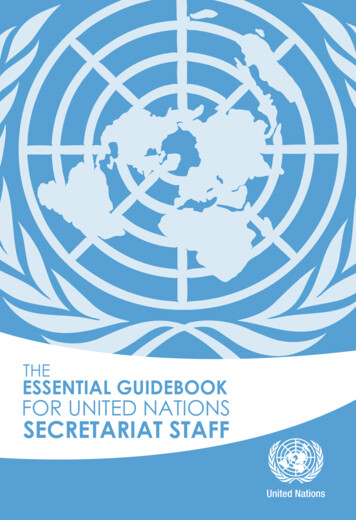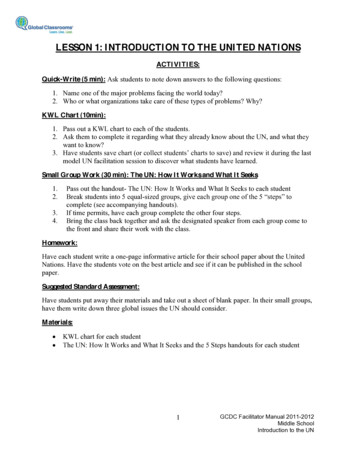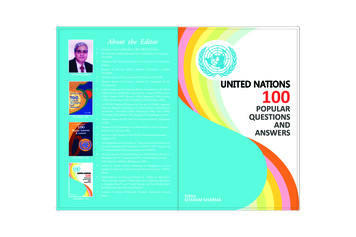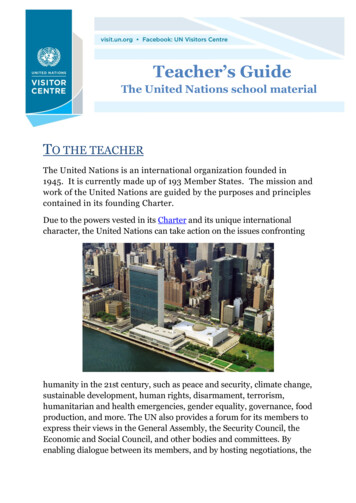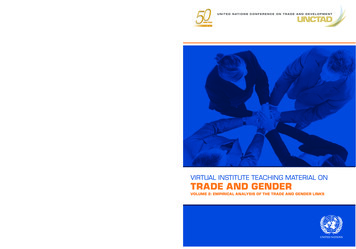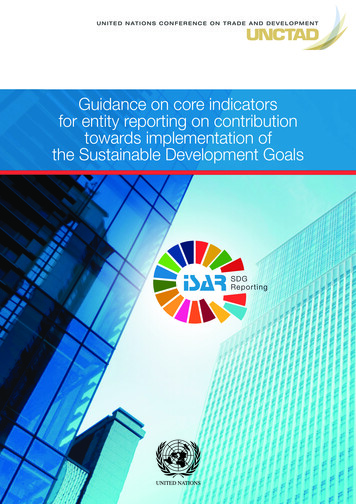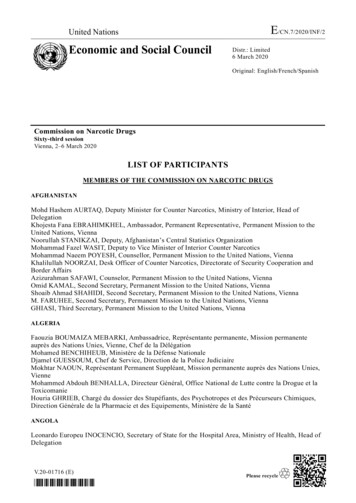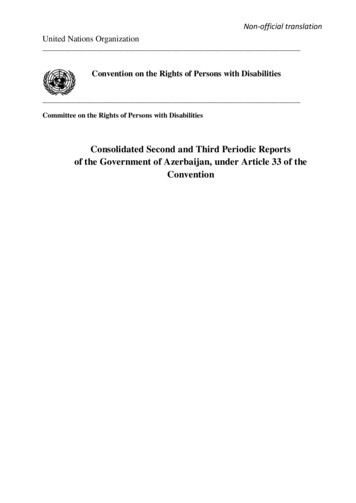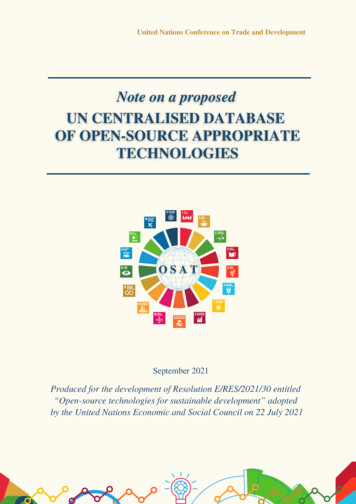
Transcription
United Nations Conference on Trade and DevelopmentSeptember 2021Produced for the development of Resolution E/RES/2021/30 entitled“Open-source technologies for sustainable development” adoptedby the United Nations Economic and Social Council on 22 July 2021
Note on a proposed UN Centralized Database of OSATACKNOWLEDGEMENTSThis UNCTAD technical note was part of the work that an UNCTAD team undertook to contribute to thedevelopment of Resolution E/RES/2021/30 entitled “Open-source Technologies for Sustainable Development”adopted by the United Nations Economic and Social Council on 22 July 2021. The team was led by Liping Zhangwith team members composed of Joshua M. Pearce (UNCTAD consultant & Professor of Michigan TechnologicalUniversity), Abiy Solomon, Maria Godunova, Bob Bell, Olivier Combe (UNCTAD New York Office) and RuslanRakhmatullin under the supervision of Angel Gonzalez Sanz, Chief of Science, Technology and ICT Branch,Division on Technology and Logistics. Shamika N. Sirimanne, Director of the Division provided general guidance.A substantive draft of the note was prepared by Joshua M. Pearce. The note was finalized by Liping Zhang andreviewed by Angel Gonzalez Sanz.Xiahui Xin designed the cover. Malou Pasinos provided administrative support.NOTEThe findings, interpretations and conclusions expressed herein are those of the authors and do notnecessarily reflect the views of the United Nations Conference on Trade and Development.The designations employed in this work do not imply the expression of any opinion whatsoever onthe part of the United Nations Conference on Trade and Development concerning the legal statusof any country, territory, city or area or of its authorities, or concerning the delimitation of itsfrontiers or boundaries.This note has not been formally edited.All references to dollars ( ) are to United States of America dollars unless otherwise stated.For further information, please contact: stdev@unctad.orgii
EXECUTIVE SUMMARYOpen source allows users the freedom to control their technology while sharing knowledge and encouragingcommerce through open exchange of designs. Open licenses contain a viral restriction and changing existingdesigns requires re-sharing the new design within the same license. This well-established method encourages rapidinnovation and is regarded as a mainstay in software development. The same concept is now used for physicalproducts and the open-source technical development method is in exponential growth in hardware development.Millions of open-source products are shared by the global community from consumer goods to scientific andmedical equipment. New digital manufacturing and recycling techniques enable individuals and communities tofabricate their own products for less than the price of purchasing them. This model has been proven to be effectivefor emergency manufacturing during the COVID-19 pandemic.One area particularly ripe for open-source development and knowledge sharing is “appropriate technology”.Appropriate technologies encompass technological choices and applications that are small-scale, economicallyaffordable, decentralised, energy-efficient, environmentally sound and easily utilized by local communities to meettheir needs. Therefore, the trend in appropriate technologies is towards relatively simple and non-complextechnologies, such as solar cookers.One way the appropriate technology movement is modernizing to overcome intellectual property (IP) barriers isto blend with the open-source approach to technology development in order to overcome many of appropriatetechnologies’ shortcomings as a technology change model and completely breaking away from IP restrictions.Open-source appropriate technology (OSAT) is an appropriate technology that contributes to the achievement ofsustainable development goals (SDGs) while being designed in ways synonymous with free and open-sourcesoftware (FOSS) and free and open-source hardware (FOSH).Free and open-source software (FOSS) is software that is both free software and open-source software. Unlikeproprietary software, FOSS is available in source code (open-source) form, and can be used, studied, copied,modified and redistributed without restriction, or with restrictions that only ensure that further recipients have thesame rights as those under which it was obtained. Today free and open-source software (FOSS) plays the dominantrole in software development globally and there is burgeoning rise in digital manufacturing, which make free andopen-source hardware (FOSH) not only physically possible, but economically advantageous. The innovation cyclein open-source technology is much more rapid than the conventional intellectual property (IP)-focused process.Both FOSS and FOSH go beyond open access, granting users substantial freedoms to build on the intellectualwork of others. FOSH provides the “source code” for physical hardware including the bill of materials, schematics,computer aided designs (CAD), and other information such as detailed instructions needed to recreate a physicalitem.The OSAT approach, even in areas such as medical research, radically reduces the costs even in the upfrontinvestment and can be funded publicly, while earning a high return on investment.Examples of how open-source can contribute to SDGsTo meet the SDGs, it is imperative that developing countries have access to a broad knowledge base. Access torelevant knowledge can significantly improve the quality of life in developing communities and solve the challengeof sustainable development. Examples of how open-source including FOSS and FOSH can contribute to SDGsinclude: SDG 2. An automatable, field camera track system for phenotyping crop lodging and crop movementSDG 3. Osmar, an open-source autosampler. Commercial microsyringe manipulation is common forautomated sampling of liquids or gases and normally costs over 30,000. Osmar is a viabletechnically-accessible alternative that can be adapted and expanded for more general liquid handlingtasks and be built for under 1,000. Loss of life could be prevented by known technologies whoseiii
availability is restricted by causes such as paywalls on articles under copyright, which restrict the freeflow of information or companies leveraging patents to restrict the manufacturing of medical products(e.g. restricting the sale of antiretroviral drugs to treat HIV). SDG 4. The OpenFlexure Microscope is a 3-D-printed laboratory-grade motorized microscope, whichwas co-developed between the University of Bath, UK and the Tanzanian engineering companySTICLab. It replaces commercial tools that cost over 30,000 for under 100. SDG 6. An open-source, programmable pneumatic setup for operation and automated control ofsingle- and multi-layer microfluidic devices. SDG 7, SDG 2. Sharing technology of solar cookers or solar bakeries can be advantageous in termsof having no recurring costs, the potential to reduce drudgery, the improvement of indoor air quality,the high nutritional value of food they produce, and high durability. SDG 8. OpenDesk which is a global platform for local making, uses a business model for open-sourcefurniture made with distributed on-demand manufacturing. Anyone can download the design files andcut it out on their own open-source CNC (computer numeric controlled) mill. Local economicdevelopment occurs because of local manufacturing and sales. SDG 15. ImageJ which is an open-source image processing and analysis software package originallydeveloped to look at microscopic organisms. Because it is open source and highly adaptable, it is evenbeing used for remote sensing work carried out by aerial drones over enormous land areas. SDGs 1, 2, 3, 4, 11. OSAT development has already reached sophisticated devices such as opensource 3-D printers used for both the design, but also the production of OSAT in a wide range of areas.For example, RepRaps can be used for manufacturing tools for organic farming, to make microscopesfor medical clinics or for full optical labs in schools and research facilities in developing communitiesfor far less cost than conventional means. Open-source 3-D printers are used to create thousands offree 3-D printed hands and arms for those in need of an upper limb assistive device from open-sourcedesigns, with significant cost reduction.The need for a centralised open-source databaseA database of OSAT could have potential to accelerate discovery and innovation across all sectors associated withthe SDGs, while minimizing legal or financial impediments. Technical information made available via opensource methods can overcome barriers to the building and dissemination of the global stock of knowledge,particularly in developing countries.Currently, there is no comprehensive repository or central database of OSAT, including technologies with expiredpatents, patented technologies that are freely licensed (with conditional or unconditional use), and free and opensource technologies. Many organizations, non-profits and for-profit companies are developing OSAT andmaintaining existing small-scale databases. While many OSAT are available, they are scattered in variousdatabases for particular technologies. Meanwhile, there remains a distinct need for increasing the use rate ofOSAT. Therefore, there is an urgent need for a trusted, global centralised open-source database (COSD).Being global in scope, a COSD repository would provide a one-stop-shop that everyone can access to solve localchallenges. Appropriate technologies that are relevant to the SDGs would be expected to make up the core of theCOSD. COSD would thus cover all technical areas. In addition, the COSD will not be limited to specific sectorsor applications, as open-source technologies can often solve problems far outside the scope of their intended use.For example, ImageJ is an open-source image processing and analysis software package originally developed tolook at microscopic organisms. Because it was open source and highly adaptable, now it is being used for remoteiv
sensing work carried out by aerial drones over enormous land areas. In the COSD, all information, data, plans, fulldigital design and manufacturing files, instructions for assembly and use, etc. are available and free.UN is rightly positioned to host the COSDThe United Nations (UN) is well placed to take a lead in the establishment of a COSD given its well establishedrole in advocating open-source technology through various intergovernmental forums and publications. Inparticular, the 2030 Connect is a UN online technology platform that was developed as part of the work of the UNInter-Agency Task Team. The COSD could enhance it by being incorporated into the 2030 Connect. The successof the COSD depends on support from the UN Member States as well as collaboration and cooperation among UNagencies including United Nations Conference on Trade and Development (UNCTAD), UN Department ofEconomic and Social Affairs (DESA), United Nations Development Programme (UNDP) and UN regionalcommissions. Private sector engagement in COSD is equally important. For example, companies that alreadybelonging to organizations like Open-Source Hardware Association may find it beneficial to share their owndesigns with the COSD.v
ABBREVIATIONS & HOAmerican Society of Mechanical EngineersComputer aided designsComputer numeric controlledCentralised Open-source DatabaseDepartment of Economic and Social AffairsDo-it-YourselfDistributed Recycling and ManufacturingEngineering for ChangeFood and Drug AdministrationFree and open-source hardwareFree and open-source softwareFused Particle FabricationGrassroots Innovation Augmentation NetworkInformation and Communication TechnologyElectrical and Electronics EngineersIntellectual PropertyNational Institutes of HealthOpen-source appropriate technologyOpen-source EcologyOpen-source Hardware AssociationPersonal Protective EquipmentReturn on Investmentsustainable development goalsTech Access PartnershipUnited NationsUnited Nations Conference on Trade and DevelopmentWorld Health Organizationvi
TABLE OF CONTENTSACKNOWLEDGEMENTS . iiNOTE . iiEXECUTIVE SUMMARY . iiiABBREVIATIONS & ACRONYMS . vi1. INTRODUCTION .12. BACKGROUND TO OPEN-SOURCE TECHNOLOGIES .12.1 Free and open-source software . 12.2 Free and Open-Source Hardware . 22.3 Distributed Recycling and Manufacturing . 82.4 What we learned about intellectual property and open source from COVID . 92.5 Harnessing the Maker Movement . 93. A CENTRAL OPEN-SOURCE DATABASE FOR SUSTAINABLE DEVELOPMENT GOALS .104. EXISTING DATABASES AND POTENTIAL PARTNERS .125. DOWNLOADED SUBSTITUTION VALUE AND RETURN ON INVESTMENT .166. WHY THE UN SHOULD TAKE THE LEAD.177. CONCLUSIONS .19vii
List of boxesBox 1: Custom Prosthetics for 1/100th of the cost for SDG 3. 4Box 2: Examples of low-cost scientific FOSH for SDG 2 and SDG 6 . 6Box 3: Open Flexure Microscope for SDG 4 . 7Box 4: Distributed Manufacturing for SDG 8 . 8Box 5: How DRAM works for SDG 12 . 9Box 6: Solar Bakery for SDG 2 and SDG 7 . 11Box 7: Offerings at the Open-Source Ecology . 14Box 8: Osmar, an open-source autosampler for SDG 3 . 16Box 9: Open-Source Syringe Pumps . 17List of figuresFigure 1. Articles indexed by Google Scholar on FOSS and FOSH . 3Figure 2. Geographical spread of global fab labs (left) and makerspaces (right) as of January 2021 . 10viii
NOTE ON A PROPOSED UN CENTRALIZED DATABASE OF OSAT1. INTRODUCTIONThe United Nations has been discussing for some time the use of open-source technologies, such as free and opensource software (FOSS) and open access to knowledge to drive sustainable development. The United NationsConference on Trade and Development (UNCTAD) has focused on this area in the E-Commerce and DevelopmentReport 20031 and concluded “The advantages for developing countries of promoting policy that will provide apositive environment for open-source IT are manifold.” Later, the Information Economy Report 2012 2summarized the benefits of open-source for use in the public sector as follows: (i) lower costs and local valuecreation, (ii) promotion of local learning with universal information and communication technology (ICT) access,(iii) less dependence on specific technologies or vendors (e.g. no lock-in), (iv) easy adaption to meet local needswith customizability to local languages and cultures, and (v) addresses concerns of national security and long-termavailability. The 2012 report concluded:Rather than purchasing software licences and services abroad, local FOSS 3 development, sales andservices can help keep resources within the local economy, avoid dependency on specific vendors andprovide opportunities for income generation and employment. When based on FOSS, local softwarecompanies may be in a better position to develop innovative and cost-effective solutions that are customizedto meet specific needs in the domestic market. As noted earlier, such capabilities are essential to seize fulldevelopment benefits from improved access to ICTs.Today, free and open-source software (FOSS) plays a dominant role in software development globally. There isalso a burgeoning rise in digital manufacturing activities, which make free and open-source hardware (FOSH) notonly physically possible, but economically advantageous. The innovation cycle in open-source technology is muchmore rapid than the conventional intellectual property (IP) focused process.4 The COVID-19 pandemic has madethe use of accelerated open-source and distributed manufacturing approach apparent. As highlighted in theintergovernmental deliberations at the 15th session of the UN Commission on Science and Technology forDevelopment (CSTD) in 20125, there is now consensus that technical information made available via open-sourcemethods can help overcome barriers to the building and dissemination of the global stock of knowledge,particularly in developing countries. Today, millions of open-source technologies are scattered across variouswebsites and there is no comprehensive repository of free and open technologies. Therefore, a platform of publicdomain technologies could potentially accelerate discovery and innovation across all sectors associated with theSDGs6, while minimizing financial and IP-related barriers.This technical note provides: (a) a background on open source technologies, (b) describes the proposed database,(c) catalogues existing initiatives, (d) provides a means of calculating the value of open-source technologies andthe return on investment for financing them, and (e) discusses why the UN should take a leadership role inproviding a global universal database.2. BACKGROUND TO OPEN-SOURCE TECHNOLOGIESThe open-source technical development method has grown to dominate software, and it is now in exponentialgrowth in hardware development. New digital manufacturing and recycling techniques enable individuals,organizations and communities to make their own products for less than purchasing them, and this model has justproven effective as an emergency manufacturing response during the COVID-19 pandemic. This is the right timeto harness the international Maker movement7 and formulate an open database to avoid intellectual bottlenecksfor sustainable economic development.2.1 Free and open-source softwareFree and open-source software (FOSS) is software that is both free software and open-source software.8 FOSS isavailable in source code (open-source) form, and can be used, studied, copied, modified and redistributed withoutTABLE OF CONTENT1
restriction, or with restrictions that only ensure that further recipients have the same rights as those under which itwas obtained.With the majority of large companies contributing to open-source software projects,9 it has become a dominantform of technical development. 10 All supercomputers 11 and 90% of cloud servers run open-source operatingsystems. Effectively, every click on Facebook, Twitter, Walmart, Wikipedia, Yahoo, YouTube or Amazon uses amachine running FOSS.12FOSS is increasingly embraced by the business world with 90% of the Fortune Global 500 companies now usingthe open-source Linux operating system.13 In addition, over 84% of the global smartphone market is open-source,using Google’s Android operating system,14 and more than 80% of the “internet of things” devices use FOSS.15In the FOSS ecosystem, there are equivalent software packages for the vast majority of proprietary programs.16For example, Libre Office, a free office suite, is used on hundreds of thousands of computers across the world. Inparticular, it is used by the government of France, the government of the Spanish autonomous region of Valenciaand Italy's Ministry of Defense. In Brazil, Universidade Estadual Paulista uses it as part of a larger migrationtowards FOSS.17These countries and regions are not alone. A growing number of governments worldwide have embraced the useof FOSS.18 For example, China developed its open-source Kylin operating system. By 2019, the NeoKylin versionof this operation system has been made compatible with over 4,000 software and hardware products and was preinstalled on most computers sold in China.19 Together, Kylin and NeoKylin have 90% of the domestic operatingsystem market share in the government sector.20 Similarly, other countries are embracing this approach to FOSSoperating systems and programs. Some European countries like Finland21 have open-source policies, the Indiangovernment announced a policy on adoption of FOSS,22 as has Peru,23 Brazil24 and South Africa.25 Ecuador26has encouraged distribution of low-cost computers running Linux and uses Libre software in the public sector. Inthe U.S., the federal government has a policy that mandates a percentage of custom source code be released asopen-source.272.2 Free and Open-Source HardwareFree and open-source hardware (FOSH) builds on the same sharing philosophy and rights of users that underliesthe success of FOSS28. As defined29 by the Open-source Hardware Association (OSHWA), a FOSH design isshared publicly, so that anyone can study, modify, distribute, make, and sell the design or hardware based on thedesign. Thus, both FOSS and FOSH go beyond open access, granting users substantial freedoms to build on theintellectual work of others. FOSH provides the “source code” for physical hardware including the bill of materials,schematics, CAD, and other information such as detailed instructions needed to recreate a physical item. As wellestablished in FOSS development, research-related FOSH is now demonstrating improved product innovation.30,31FOSH is rapidly gaining momentum and trails behind the historical rise of FOSS by about 15 years (see Figure 1below).There has been a consistent increase in the emergence of FOSH-based electronics, even if at a rate that is slowerthan free and open-source software. It is now possible, for example, to automate and control almost any electronicdevice using open-source microcontrollers like the Arduino.32 The Arduino is a family of microcontrollers, whosefunctionality has been built up by a global open-source community on a wide range of thousands of projects,33from automated irrigation systems,34 to nitrate testing for optimal crop fertilization,35 to low-cost baby monitorsin Africa.362
NOTE ON A PROPOSED UN CENTRALIZED DATABASE OF OSATFigure 1. Articles indexed by Google Scholar on FOSS and FOSH(a logarithmic scale is used because of the orders of magnitude changes)Source: Pearce, J.M. Sponsored Libre Research Agreements to Create Free and Open-sourceSoftware and Hardware. Inventions 2018, 3, 44.37Even in relatively mature open hardware areas like open-source electronics, the designs are separated in manylocations. There are many scattered repositories open to any global citizen to download for free various opensource electronics including: Open Electronics,38 Open Hardware Repository,39 Open Circuits Institute,40 OpenCircuits Wiki,41 Hackster,42 Codemade43 and Hackaday.44 All these websites allow both users and developers todiscover and share open-source projects. In addition, the catalogues of open-source electronics companies, whichcontain the full source code for their thousands of products, are also de facto repositories including Sparkfun,45Adafruit,46 Tiny Circuits47 and Seeed Studio.48Users are free to download and manufacture the electronics using open-source printed circuit board mills.49Access to open-source electronics has been an enabling technology that allowed the growth in FOSH, which isnow being driven by the open-source distribution of three primary classes of digitally distributed (to the point of‘at-home’) manufacturing: 1) 3D printers, 2) laser cutters and 3) computer numerical control (CNC) mills. Eachof these three technologies has accessible starting points in the open-source ecosystem, yet they also have evolvedenough that new users can fabricate sophisticated tools that can match product available from an industrialmanufacturer. It has been suggested that digital distributed manufacturing is poised to unleash a new paradigmshift equivalent to an industrial revolution.50 Yet, the OS growth of these technologies proves the potential for thisindustrial revolution to be democratized, which holds incredible promise for developing communities.51Although 3D-printing and additive manufacturing are now an old technology, it has gained popular attention onlyrecently when the open sourcing of the technology dropped the costs so that they became accessible to most of theworld’s population.52 Today, the most popular desktop 3D printer, Creality Ender 3, made in China, is open-sourceand can be purchased for under 200.53 Yet these low-cost and open-source 3D printers derived from the self-TABLE OF CONTENT3
REPlicating RAPid prototyper (RepRap) project 54 are capable to produce parts as mechanically functional inapplications as those from commercial 3D printers (costing over 20,000).55A recent development of open-source 3D-printers makes the scaling of mass-distributed additive manufacturingof high-value objects technically feasible for much of the world from open-source plans.56 RepRap solutions holdpromise in the developing countries.57 They can fabricate many of their own parts, so can be fixed without accessto supply chains. They are open source so they can be upgraded easily. They literally have been evolving underthe open-source paradigm.58Selecting from millions of free designs, communities can radically reduce costs for a wide range of products by3D printing them for themselves. They include children’s toys,59 learning aids,60 drones,61 photovoltaic racking,62and medical equipment, such as braces for clubfoot,63 and prosthetics (see Box 1),64 self-adjustable glasses,65 andadaptive aids for arthritis sufferers. 66 The free and open-source designs for these products are growingexponentially, 67 already numbering in the millions, and are currently scattered throughout dozens of onlinerepositories.68 Thus, by combining open-source designs with digital distributed manufacturing, it is possible forconsumers throughout the world to manufacture their own products for lower costs than can be massmanufactured.69Box 1: Custom Prosthetics for 1/100th of the cost for SDG 3The e-NABLE Community (http://enablingthefuture.org/), with more than 10,000 volunteer members in 140 Chapters andhundreds of schools from all over the world, are using their 3D printers to create thousands of free 3D-printed hands andarms for those in need of an upper limb assistive device from open-source designs. Prosthetics are customized for thechildren and can be produced for about 25 - reducing the commercial costs by orders of magnitude.Caption: Photographs of children using e-NABLE hands made by a global network of volunteers, including 12-year-oldMusa, a survivor of the Boko Haram attacks in Adamawa State, Nigeria.4
NOTE ON A PROPOSED UN CENTRALIZED DATABASE OF OSATOpen-source designs have even entered areas that have been historically used as examples of the needfor traditional IP such as pharmaceuticals.70 For example, Open-source Pharma’s71 mission is to createan alternative, comprehensive, open-source pharmaceutical system driven by principles of openness,patient needs, and affordability. This includes initiatives such as (a) Open-source Pharma Foundationthat has commenced a multicentric phase 2b clinical trial for an adjunct therapy for tuberculosis, reachingthis stage nearly a decade faster and for less than 1% of the cost of the conventional IP-intensivepharmaceutical approach72; (b) Open-source Malaria73 and the Malaria DREAM Challenge74, which areusing open-source principles to discover new Malaria drugs; (c) the Nipah Virus Open ResearchCollaborative, which are doing the same to find cures for the deadly outbreak of the Nipah virus in India75,and (d) the CRI in Paris76, which is developing a safe model microbe E. coli as a proxy organism toexpress and target essential metabolic enzymes from other species.By developing inexpensive, simple and safe drug discovery tools, Open-s
maintaining existing small-scale databases. While many OSAT are available, they are scattered in various databases for particular technologies. Meanwhile, there remains a distinct need for increasing the use rate of OSAT. Therefore, there is an urgent need for a trusted, global centralised open-source database (COSD).


